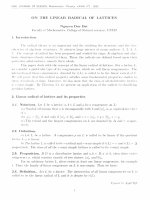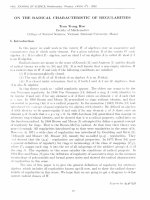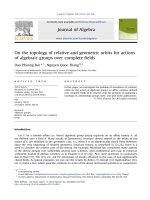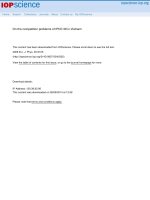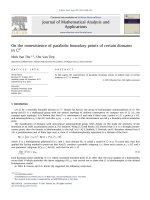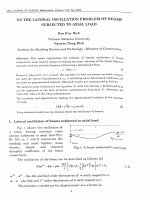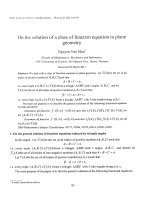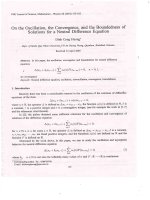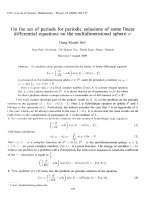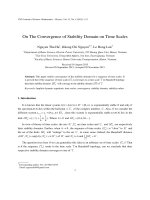DSpace at VNU: On the asymptotic equivalence of linear differential equation in hilbert spaces
Bạn đang xem bản rút gọn của tài liệu. Xem và tải ngay bản đầy đủ của tài liệu tại đây (2.5 MB, 11 trang )
VNU. JOURNAL OF SCIENCE. Mathematics - Physics. T.XVIII. N()2 - 2002
A bstract. I n this p aper we study cond ition s on the asym ptotic equivalence of d if
fe re n tia l equations in Hilbert, spaces . Besides, we d iscu ss the relatio n between p ro p
erties o f solutions o f differential equations of tria n g u la r fo r m and those, o f truncated
differential equations.
I. Introduction
Let us consider in a given separable Hilbert space // differential equations of the
form
( 1 .1 )
( 1 .2 )
where / : I V X H -> H \ (] : /?+ X // —> H are operators such that f ( t , 0) = 0, ij(tyO) = 0,
Vi € /? f which satisfy all conditions of global theorem on the existence and uniqueness
of solutions (see e.g. 1. p. 187-189]). An interesting problem studied in the qualitative
theory of solutions of ordinary differential equations is to find conditions such that (1) and
(2) are asymptotically equivalent (see e.g. [3, 4, 5, 6, 8j).
Recall ([5|, (3, p. 159]) that (1) and (2) are said to be asym pto tically equivalent if
there exists a bijection between the set of solutions { x ( t ) } of ( 1 ) and the one of {v ( 0 }
(2) such that
lim \\x(t) - (/(Oil = 0.
Í-4(X'
Let
be a normalized orthogonal basis of the Hilbert space H and let X =
53 x i€i be an element of H . Then the operator p n : H —Ï H defined as follows:
Tị
is a projection on H . We denote H n = Im p n .
Suppose that J = { n i,n 2, ... , r ij , ... } is a strictly increasing sequence of natural
numbers (rij
oo as j *-> +oo). Together with systems (1), (2) we consider the following
systems of differential equations.
8
9
O n th e a s y m p t o t i c e q u iv a le n c e o f..
^ = P m H t,rmx ),
( J - p m )x - 0,
m e ./,
(^ jj - Pn,(j{t, p ,ny),
( I - pm)y = 0,
(4)
m € ./.
III this article, we study the asymt.ofcic equivalence of a class of differential equations i l l
the Hilbert space H. We will establish conditions for which the st udy of the asymptotic
equivalence of (1) and (1) is reduced to the one of (3) and (4). Then' are SOII1 P results on
the stability of this class of differential equations (see [2, 7Ị)
I I . M ain R esults
We assume in this section the following conditions:
f ( t , p mx) = p mf ( t , p mx),
•>ï
—p
Ỉ' 7íĩ*e)ì
(5)
(6 )
(V* 6 /?+, Vm € J, Vx € H ) .
Definition 2.1. Differential equations (1) and (2) are said to be asym ptotically equivalent
by part with respect to the set J (or, simply, J - asym ptotically equivalent) if systems (3)
and (4) are asymptotically equivalent for all m £ J .
Using (5) we are going to prove the following.
Lemma 2.2. F o r any solution x ( t ) = x ( t 1tQỉ P mx o ) ĩ Xo € H o f equation (1) the following
relation
t-Qì Pm%o)
tư) Pm ^o)
holds fo r all t €: /? 4, 771. ç J , Xo G //.
Pvoof. For given rn e J , lot us consider the differential equation
-T” = /(*, Prntz);
(it
For
u € H , t e /?f .
(7)
E P m H , the solut ion u ( t ) = u(t.\to,£,o) of (7) is also a solution of the equat ion
(8)
By (5) and P m i0 = io we have
t.
■u{t) =
Pm£o + -Pm Ị
/ ( r , p mu(r))rfr
D a n g D in h
10
or
Chau
J
t
u (t) =
Pm{ç0 +
f{T ,P m U {T ))d T ^
to
Hence
u (t ) = p n iu ( t ) ,
vt € lV .
Consequently w<‘ can rewrite (8) as follows
t
u (t ) = {o +
J /(r ,u (r))d r.
This shows that u(t) = u ( t , t o,£o) is a solution of (1), as well. Denoting by x ( t ) —
x ( U t o ^ o ) the solution of equation (1) satisfying the condition x (t o ) = £()< by uniquness of
solution Wf' have:
l { t ) = u(t).
Hence, for XQ € //, any solution x ( t ) =
(1) will satisfy the relation:
PmZo), ĩĩt € J of differential equation
x { t , to, p mx o) = p mx ( t , to, P mx o).
(V* € R + ).
The Lemma is proved.
R e m a r k . By Lemma 2.2, we can see that if thẻ conditions (5) and (G) are satisfied, thon
all solutions of the equations (3), (4) are solutions of the equations (1), (2), respectively.
Therefore, from the asymptotic equivalence of systems (1), (2), we can deduce their J asymptotic equivalence.
Now we consider the following linear differential equations
(9)
(1 0 )
where v4 € £ (//), B (i) € C ( H ) y Vi € [0, oo) and
(1 1 )
0
We assume that, for them conditions (5), (6) are satisfied, that is,
(A — P rnA ) P mx = 0,
[ B ( t ) — PrnD ( t ) ) P mx = 0,
Vm G «/, Vx € H
(12)
Vra G J, Vj: € / / .
(13)
O n th e a s y m p to tic
11
e q u iv a le n c e o f...
Together with (!)). (10) w<‘ consider also tho sequences of truncated differential
reptations
' ỉ
(14)
= APmX'
( I - P „ i ) x - 0, me J,
£ - H + « !» * .» .
(/ - Pm)?/ = 0,
(15)
7716 J.
We denote by
the Cauchy operator of (14) satisfying
x m (0) = E Vi and by
y,n(f)the Cauchy operator of (15) satisfying Km(£o) = E m i where E , „ is the identity
operator in
Lemma 2.3. I f rill solutions o f equation (14 ) are b o u n d e d , then
1. T h e C tw c h y o p era to r x m(t) o f (14 ) can he w ritten in the form
X m ( t ) = ư m{t) + Vm (t),
where Um (t) and Vm{i) : H m
cn, satisfying
//m, so that there exist positive constants a m, btn,
R+,
lltu o il
(16)
\\vm(t)\\
(17)
2. T h e o p e ra to rs F,n : H —y I I defined b y
no
FmZ = f Vm(t 0 - T ) B { T ) Y m(T)P,„ZdTt
í e H
to
are h o u n d e d and m oreover the follow ing in e q u a lity is valid
Il F m II < ttm < 1,
vto > A > 0.
Proof. By the assum ption on the boundedness o f all solutions o f (14), we can see that
X rn(t) is bounded uniformly in t for every fixed 771. Since d i m I m P m < oo. the conclusion
i. of the Lemma ran be proved by the similar method of proof as in [3, p. 160-161]
Denoting by Y nl{t) the Cauchy operator of equation (15) satisfying Y m (to) = E .
Wr see that Y m (t.) satisfies the (filiations
t
y,n(t) = x m (t - to) + J x m (t - t ) D ( t ) Y m( r ) d r .
to
D a n g D in h
12
Thus,
Chau
t
||Vm(t)|| < \ \ x m (t - ío)|| + I \ \ x m (t - t)II P ( r ) | | \\Ym ( r ) \\d r .
to
By (16), (17), we have
t
\\Ym (t)\\ < a, + a , I
||B(r)|| ||ym(r)||dr,
to
where (II = 2 rnax(am>cm). From the Gronwall-Bellman inequality and (11), it follows
that
/ |ỊB(r)||đT
7 ||B(r)|ịdr
||Vm(í)|| < ( I\ e °
< a ie °
Hence, there exists a number K m independent of to so that
\\Ym (t)\\ < K mi
(18)
V teR * .
Moreover, for any Otm < 1, we can find a number A > 0 so that
4 -0 0
/ ||B ( T ) ||d T < - ^ — ,
Cm *^ 771
J
to
Vi()
> A.
This implies that
oo
||Fm|| < J ||Vm( io - r ) | | ||B (r)|| ||ym(r)||d r
to
oo
< cm K m j ||B (r)||d r < Qm < 1 ,
<0
Theorem 2.4. A ssu m e
differential equation s (9)
%
Vt0 > A.
that, for any m 6 J the so lu tio n s o f ( \ A ) a re bounded.
and (10) are J - asym totically equivalent.
Then
P ro o f For each m 6 .7 we put
“ ( / ■+■ F rn )^ ì
£ € H
m
.
By Lemma 2.3, the inequality ||Fm|| < 1 holds for to > A. Therefore, the operator
Q rn
•
>//m is invertible.
Denoting r/o =
Oî Co € / / m, 771 € */, we consider the solutions
of (14) and ỊỊ/(f) = y{t, to, 7]o) of (15). It is clear that
x (t ) = x m(t - t0)Co
x ( t ) = x ( t totio)
O n th e a s y m p t o t i c e q u i v a l e n c e o f ...
and
/
tu)no + J x m(t - T ) f í { T ) y { T ) d r .
//{/')•
*0
As was shown in Lemma 2.3. by the boundedness of all solutions of (14) we have
u m(t ~ to) + v ;„ ( i - /(,)
X ' J I - /())
v m(t - r)
x m(/ - to)Vm(to - r).
m u o n of
O I Qtn, we
w e have
nave
From the definition
X
Ço = Qm% = 7/0 -r J Vm (to - r)jB (r)y m(T)7/0rfr.
Í0
Ho11 a
00
.r(/) — x ,n (/ — / 0 ) 7/0 f Arm(/ — / 0 ) J
Vm (to - T) B ( r ) Yn
to
x m(t - t.0)Vo + ị vm(t - r ) B ( r ) y m(r)%dT.
to
Consequently,
ll?/ơ)-.r(0|| =
t
f X m{t - t ) B { t ) ị j ( t ) ( ỉ t
r ) ữ ( r ) y m (r)r/0í/r +
to
t
) B ( r ) Y m (t)riodT + J u m {t - t ) Ị 3 { t ) ị ị ( t ) < I t {
to
to
t
+ J vm{t -
t
) B ( t )y ( r ) d r
to
nee 7/(0 = y m(t)rç0 , we have
oc
II//(/.) - ./’(Oil =
t
- J v m(t - r)B {T)y[t)dr + J u m(t. - T )D{ t ) ij( t ) ( I t \
*0
to
t
+Ị
v,n(t - T)D{r)y(T)dr
to
z -
-
I v m (t t
t
)D [ t )y ( r ) d r +
J
to
u m(t - r)jB (r)y (r)d r
D ang D inh Chau
14
Using (16), (17). (18) and taking into account. y (t ) = Y m ^ r / o , we have
t
oo
\\y(t) - x{t)\\ < am K m \\r)o\\ J e” 6m(i” T)||B(r)||dr + cmK m \\riQ\\ Ị
to
or
t
t
||y (t)
\\B (r)\\d T
oo
- x(t)\\ < M l J e - b^ - ^ \ \ B { T ) \ \ d r + M 2 J \\B (r )\\d t ,
Vf > to,
t
ỀQ
where M l = a m K m \\Tio\\, A/o = cm K m \ịTỊo\\.
Thus, for every positive number e > 0, there exists a sufficiently large number t and
t > 2/o such that the following inequalities are valid
t
2
j
oo
e - bm{t- T )\\D {T )\\d r < e ~ ^ J
to
to
t
Ị
\\ B ( t )\\ cI t < ~
oo
\m r )\\ir < J L . ,
I
J
W
rW r i ^ - .
t
Hence,
i
\\y(t) - x(t)\\ <
t
J C- fc“ <‘ - T>||B(r)||dr + J e- 6"<*-T> ||B (r)||d r) +
+ M2
J
i
||B(T)ị|ưr < I + I + £ = £.
t
This means that
lim ||y(it) - x(í)|Ị = 0.
Í-4 0 0
By the uniqueness of solutions of differential equations (14) and (15), the map Q m is
bijective between two set of solutions of equations (14) and (15).
Lemma 2.5. I f all solu tio n s o f the differential equations (9) are bo u n d ed , then
1. T h e re ex ists a p o sitiv e n u m b e r A = A (or) such that
I l II < oc < 1 ,
v < 0 > A, Vm € J;
2 . {F ni} a n d ị Q m } are convergent sequences o f o pera to rs as m -» oo.
Proof. By the boundedness of all solutions of (9), there is a number 01 > 0 such that the
Cauchy operator X(t) of (9) satisfies relation
\\x m < 0 u
Ví e R + .
15
O n th e a s y m p to tic e q u iv a le n c e o f...
Denoting by Y(t.) the Cauchy operator of (10) satisfying Y ( t o ) — E we SCO that
Y ( t ) satisfies the rqiiHtion
Y(t)
X ị t - to )
/ X( t - T) B( t ) Y{t ) ( Ị t
h -
4-
h)
Hcnc
t
ll>V)|| < |Ị-V(/ - /o)j| - I ||X (Í - r ) | | |ỊS(r)|| ||y(r)||rfr
/0
t
J ||ỡ(r)|| \\Y(r\\dT.
<01 +i h
Co
By thí' Gronwatl - Bellman inequality and (11) there exists a number ỈÌ 2 independent
of t[) and m such that
\ \ Y \ m < i h , V i€ / ? + .
( onsrqucntly,
\\xm{t)\\ < 0 1 ,
\\Yrn{t)\\
< 02,
Ví € / ỉ \ Vrn € ./.
Oil I hr oilier hand, for any 0 < (\ < 1 wo can find a number A — A (a) > 0 such that
'X'
[ \\I'ỉự)\\dT <
./
tu
—
Pi •P2
< +OC,
VỈ0 > A.
Analogously, as in the proof of Lemma 2.3, we have
p'mll < f ||K „ ( io - r ) || ||5 (r)|| \\Yn i( r ) \ \ d r
i(>
X
< 01 •fa
J ||j3(r ) | | d r
< a < 1,
Vm € ./, V/,0 > A.
*0
By (lefinrrion.
fm =
[
V f n ( l . Q - T ) B ( T ) Y m ( T ) P m £(t T.
Ji0
From (12) and (iii) wo ran show that for all m,m 4- /> 6 J,p > 0,
V£ € H
V£ 6 //.
X n + P(t - to)P rnt = x m (t - t o )P m&
Y m+ p{ t ) P mị = Y m ( t ) P m^
Hence.
m+pf rn£ ~
ml ITI^I
V/7?.,77l 4~p 6 «Ap ^ 0.
D ang D inh Chau
16
We now prove the convergence of { F m}. In fact, for Vm,m + p £ J , p > 0, we have
\\Fm+ p - F rnII = \\Fm+ pPm±p - F m p m \\
= ||Fm+p(Pm+p - pm) + ( F m+P - F m ) p mII
= ||Fm+p(P m + 1 - pm)||
< ||Fm+p||||Pm+p- P m||.
By definition, limm-+oo-Pm = I- Hence, by the boundedness of F m the abovo yields that
{F m} is a Cauchy sequence, so { F m } is convergent. This implies the convergence of {Q m}.
Theorem 2.6. I f nil solu tio n s o f the differential equation (9) are b o u n d e d then the equa
tions (9) and (10) are a s y m p to tica lly equivalent.
Proof. By virtue of Lemma 2.5, we can put:
F=
lirn Fm
r n —i n o
and
lim
m —* oo
Hence, Q = / + F . Since ||Fm|| < a < I , V m e J, V/-0 > A, we have
||F ||< a < l,
V/.Q > A.
Therefore, Q : /■/ —» H is an invertible operator. By the uniqueness of solutions of
equations (9) and (10) we deduce that the map Q is also bijectivo between two sets of
solutions {#(/)} °f (9) and { y { t ) } of (10). Let yo = Q ~ l x 0 and x ( t ) = X ( t - io)^o,
y{t) = Y ( t ) y 0 . Since
Jim
Ptntfo == Ĩ/0 )
m —>oo
Jim Ọmỉ/ 0 = Qs/O = ^0 ,
m —►oo
we can see that for any given £ > 0, there exists sufficiently large mi € .7 such t hat for all
m > mi Wf* have for vt > É0
lly(í;ío,ỉ/o) - y(í;ío,Pmyo)ll <
||x(í;ío,ì/o) - i(í;< o,Q t,,yo)ll <
By virtue of Theorem 2.4 and the boundedness of all solutions of (9), we deduce that
differential equations (9) and (10) are J - asymptotically equivalent. Consequently, then'
e x ists
To € (toyOo) s u c h t h a t f o r V J > T o ,
||z(i;fo,Qm,yo) - y(t-,t0y p m iy0)\\ <
where to is choosen sufficiently large such that
ll^mll < or < 1,
Vm € ./.
17
O n th e a s y m p t o t i c e q u iv a le n c e o f..
Theroforo,
IIy (l: /(,. //,)) -
II < ||y(jt; if), i/o) - y(t- to, Pm, ?/o)|| +
+
to, Pin I i/o ) - -í-ơ, í(), Qm, + ||x(i; t o , Q mi i/o) — ; /(1 , .ỉ'() ) II
£
£
€
s 3 + I + I =£! Vl - T,h
This implies that
lirn*x; ||.r(i:i(), Xo) - y (t; to, y0)ll = 0 .
t —*
By virtue of tin* Lrmma 2.2 we get:
C o ro lla ry 2.7 Assume' that all solutions of the differential equation (9) arc* bounded.
Then, the differential (‘quations (9) and (10) are asymptotically equivalent if and only if
they are ./ - asymptotically equivalent.
C o ro lla ry 2.8 If all solutions of differential equations (14) are uniformly bounded for all
ỈÌI £ ./. then differential equations (9) and (10) is asymptotically equivalent.
References
1. E. A. Barlmsllin, In tro d u ctio n to the stability theory, Moscow, uScirric
2. Dang Dilih Chau, St udying ! he instability of the infinite systems of differential equa
tions by general charartoristic number, S c ie n tific B u lle tin ( B E C T N I K ) o f N ation al
U n iv e rsity o f B ela sru s , S r r i c 1 , Physics. M aths and M echa n ics, 1(1983), p. 48-51
(in Russian).
3. B. P. Demidiviteh, Lectures on the m athem atical theory o f stability, Moscow, “Sci
ence” 1967.
4. G. Elouthoriadis, M. Boudourides, On the problem of asymptotic equivalence of
ordinary ilifferrntial equations. Itnl. J . P u re Appl. Math., 4(1998), p 61-72.
5 N. Levinson. Thi' asymptotic behavior of systems of linear differential equations,
A m er. J. M ath., 63(1946). p. 1-6.
(). .1. Miklo, Asymptotic relationship between solutions of two linear differential sys
tems, M athcrnatica Bohémien. 123(1998), 163-175.
7. Vu Tuan, Dang Dinh Chau. Oil the Lyapunov stability of a class of differential equa
tions in Hilbert spams, S c ic n tific B u lle t in o f U n ive rsitie s, M aths S trie . Vietnam,
1996.
8. Choi Kyu Sung, Hoe G oo Yoon. Jip K oo Nani, Asym ptotic, equivalence between
two linear (iiíĩ
D a n g D in h
18
Chau
TAP CHÍ KHOA HỌC OHQGHN. Toán - Lý, T. XVIII, Số 2 - 2002
V Ề s ự TƯƠNG Đ U Ơ N G T IỆ M CẬN C Ủ A C Á C P H U Ơ N G TR ÌN H
VI P H Â N T U Y Ế N TÍN H T R O N G K H Ô N G G IA N H IL B E R T
Đảng Đình Chàu
Khoa Toán Cơ Tin học
Đại học Khoa học Tự nhiên - ĐhlQG Hà Nội
Trong bài báo này chúng tôi nghiên cứu sự tương đương tiệm cận của các phương
trình vi phân trong không gian Hilbert. Đồng thời chúng tôi cũng đã chi ra mỏi liẽn hệ giữa
tính tương đương tiệm cận cùa các phương trình vi phàn dạng tựa tam giác trong không 2Ían
Hiibert và tính tương đương tiệm cận cúa các phương trình vị phãn được cắl ngắn tương
